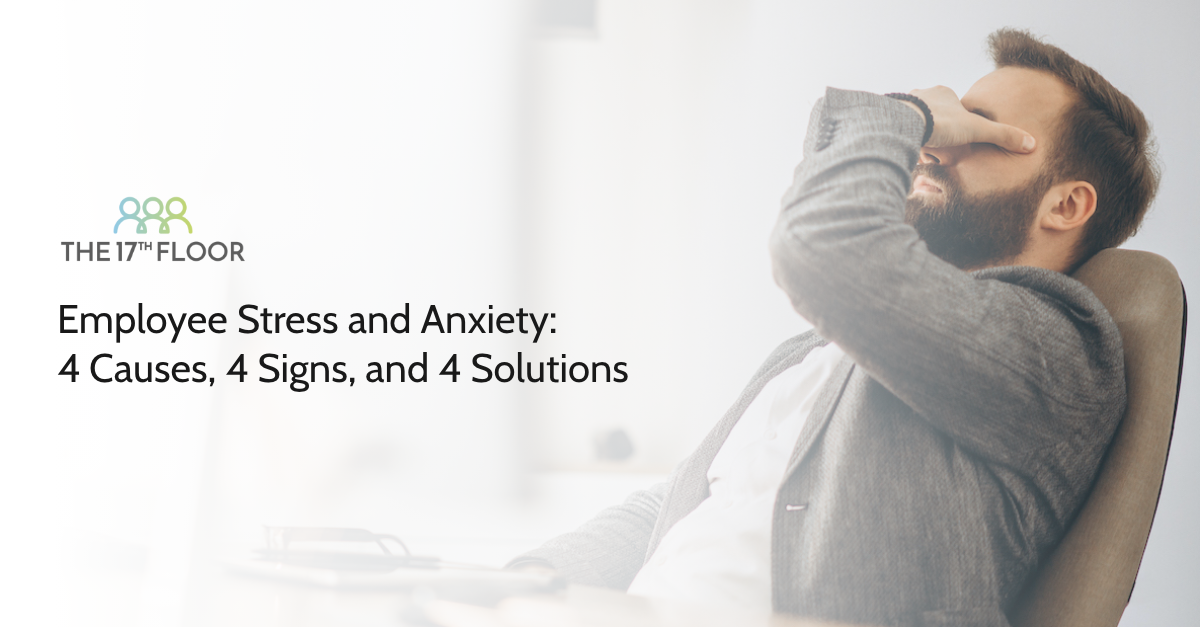Employee Stress and Anxiety: 4 Causes, 4 Signs, and 4 Solutions

Stress and anxiety are becoming more and more common in the workplace, and yet many employers and workers don’t know how to address these issues. It’s not uncommon for people to feel overwhelmed by their workload or anxious about their future at work. It’s time to start taking action to create a healthier, more productive work environment.
Companies know this. Now more than ever, they address mental health issues at the workplace and try their best to lower their impact. However, to achieve this it is essential to learn their causes and know how employers can detect these signs in employees in the first place.
What Can Cause Employee Stress and Anxiety?
A Heavy Workload
An unmanageable workload, tight deadlines, and high job demands can cause stress and anxiety for employees. Adding a lack of control, meaning they don’t have control over their work or decisions, can add to more anxiety.
Role Ambiguity
Unclear job roles, lack of direction or guidance, and unclear expectations can cause stress and anxiety. This can be the case when there are changes in the company’s structure, policies, or leadership.
Discrimination and Harassment
Discrimination or harassment in the workplace can cause significant stress and anxiety, especially when employees lack support from their colleagues or supervisors.
Work-life Balance
Difficulty balancing work and personal life can lead to anxiety and guilt. It is important to draw a line between the personal and professional sides to be able to be productive and successful with both.
How Can I Detect Stress and Anxiety in Employees?
Changes in Mood and Behavior
Employees experiencing stress and anxiety may change their mood or behaviour, such as becoming withdrawn, irritable, or easily frustrated. They may also have difficulty concentrating and appear disorganized or forgetful. They won’t seem like themselves.
Decreased Productivity
An employee who is stressed or anxious may have a decrease in productivity, miss deadlines or make more mistakes than usual.
Increased Absenteeism
Stress and anxiety can cause an employee to increase absenteeism by taking more sick days or arriving late to work, directly impacting productivity.
Social Withdrawal
Employees who are stressed or struggling with mental health issues may avoid social interactions or meetings and become more isolated.
How Can Employees Fight Stress and Anxiety?
Take Breaks
Taking short breaks throughout the day can help employees recharge and refocus. Going for a walk, stretching, practicing deep breathing exercises, or doing mindfulness are great techniques that can help reduce stress and anxiety by improving focus and increasing relaxation.
You can also try these 5 easy exercises to try from your desk!
Manage Expectations
Workers should manage expectations by setting realistic goals and deadlines. Communicating clearly with managers or supervisors about what they can realistically accomplish is key. The first step could be prioritizing tasks based on their importance and urgency.
Learn New Skills
Learning new skills to improve job performance can build the employee’s confidence. They can achieve this by attending workshops, seminars, or online training courses that will help them develop new knowledge. Gaining new abilities for their job can work as a motivational boost.
Seek Support
Reaching out to colleagues, friends, or family members for support is vital when someone wants to overcome stress and anxiety. If you are an employee struggling with these issues, share your feelings and concerns with someone you trust. If you are an employer, reach out when you see concerning signs in your team.
As we’ve seen, it is essential for managers and employees to address stress and anxiety in the workplace and how doing so can help create a more positive and productive environment for everyone. Creating a safe and supportive workplace culture and supporting colleagues when they experience stress and anxiety is paramount.
How stress and anxiety are handled in your company? Share in the comments if your organization has a wellness plan in place and what actions they take.
Absenteeism, Employee Motivation, Mental Health, Stress and Anxiety, Wellness, Work-Life Balance

Denise Burnett
Our organization is very supportive of employee wellness, taking breaks, taking sick days when needed, and ensuring staff achieve a healthy work/life balance. Staff development and growth is also highly encouraged and efforts to find a good fit for staff is very collaborative between employees and leadership. We also have a great Wellness Team that offers wonderful supports, events, and resources throughout the year.